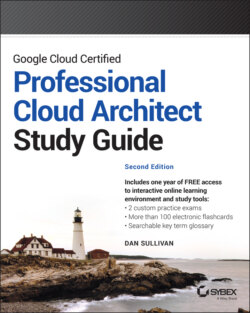Читать книгу Google Cloud Certified Professional Cloud Architect Study Guide - Dan Sullivan - Страница 13
Introduction
ОглавлениеThe Google Cloud Platform is a diverse and growing set of services. To pass the Google Cloud Professional Cloud Architect exam, you will need to understand how to reason about both business requirements and technical requirements. This is not so much a test of knowledge about how to do specific tasks in GCP, such as attaching a persistent disk to a VM instance, which is the type of question you are more likely to get or see on the Google Cloud Associate Cloud Engineer exam. The Google Cloud Professional Architect exam tests your ability to perform high-level design and architecture tasks related to the following:
Designing applications
Planning migrations
Ensuring feasibility of proposed designs
Optimizing infrastructure
Building and deploying code
Managing data lifecycles
You will be tested on your ability to design solutions using a mix of compute, storage, networking, and managed services. The design must satisfy both business and technical requirements. If you find a question that seems to have two correct technical answers, look closely at the business requirements. There is likely a business consideration that will make one of the options a better choice than the other. For example, you might have a question about implementing a stream processing system, and the options include a solution based on Apache Flink running in Compute Engine and a solution using Cloud Dataflow. If the business requirements indicate a preference for managed services, then the Cloud Dataflow option is a better choice.
You will be tested on how to plan the execution of work required to implement a cloud solution. Migrations to the cloud are often done in stages. Consider the advantages of starting with low-risk migration tasks, such as setting up a test environment in the cloud before moving production workloads to GCP.
The business and technical requirements may leave you open to proposing two or more different solutions. In these cases, consider the feasibility of the implementation. Will it be scalable and reliable? Even if GCP services have high SLOs, your system may depend on a third-party service that may go down. If that happens, what is the impact on your workflow? Should you plan to buffer work in a Cloud Pub/Sub queue rather than sending it directly to the third-party service? Also consider costs and optimizations, but only after you have a technically viable solution that meets business requirements. As computer science pioneer Donald Knuth realized, “The real problem is that programmers have spent far too much time worrying about efficiency in the wrong places and at the wrong times; premature optimization is the root of all evil (or at least most of it) in programming.”1 The same can be said for architecture as well—meet business and technical requirements before trying to optimize.
The exam guide states that architects should be familiar with the software development lifecycle and agile practices. These will be important to know when answering questions about developing and releasing code, especially how to release code into production environments without shutting down the service. It is important to understand topics such as Blue/Green deployments, canary deployments, and continuous integration/continuous delivery.
In this context, managing is largely about security and monitoring. Architects will need to understand authentication and authorization in GCP. The IAM service is used across GCP, and it should be well understood before attempting the exam. Cloud Monitoring and Cloud Logging are the key services for monitoring and logging in GCP.
